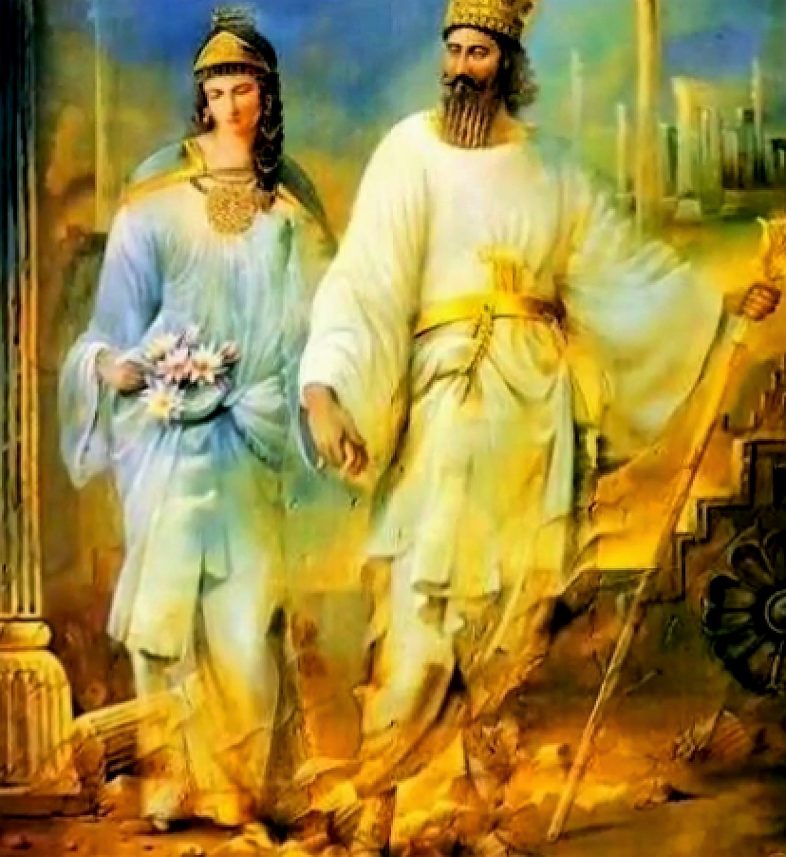Mesopotamians hailed Marduk Lord, God of the Universe, Golden Calf of the Sun, Son of the creator God, Enki, Most beloved God, hero of the gods and the people and Slayer of Tiamat, the mighty dragon and symbol of the chaos of primordial creation and threat to gods and humanity.
Before Marduk of the 50 names given to him by the gods, and crowned by them God king over all gods and men, Marduk the God of all Gods was a man, mortal like all other men, and son of a man and woman, like all other men and women.
History and myth know Marduk, the supreme God of Heaven and Earth, but they do not the man. Too many names for him existed in too many forms spelled in too many different ways:
– Logographic spellings include: AMAR.UD/UTU, dAMAR.UD/UTU, dAMAR.UD/UTU.KAM, dAMAR.UD/UTU.KÁM,dDUMU.Ú.TUK, dŠÀ.ZU, dMES, dTUŠ.A(?), dŠÚ, dKU, dEN;
– Syllabic spellings include: ma-ru-tu-uk, dma-ru-tu-uk-ku, ma-ru-tu-UD, dmar-duk;
– The constellation Marduk was spelled: mulAMAR.UD/UTU or mul.dAMAR.UD/UTU;
– Normalized Forms include: Marduk, Martuk, Merodach (Biblical Hebrew), Mardochaios (Greek), Mĕrôdāk (Masoretic Hebrew), Marōdak (Septuagint); Bel (only for logographic spelling dEN)
https://www.youtube.com/watch?v=qOFIOtEn26w
The story of Marduk the man may have started with his father and mother. Both were living in an oasis in south East Arabia that bears his name to this very day – Adam in the Governorate of Dakhilia of Oman. At one time the oasis had 24 subterranean streams.
Water is life so life was as abundant as the water. His father’s small clan knew water as *H’, a two letter very ancient root invented by their forefathers. When they needed to identify things nourished to life by water they added a letter to this two letter root. ‘Hay’ was born out of the linguistic womb of *H’ and understood by the clan to mean “alive”. ‘Hayya’ was another linguistic baby of mother *H’ and it meant “serpent”. The speed of serpents, their elegant slithering and their elasticity fascinated Adam and his clan. They regarded it as a symbol of the moving life.
Who besides water is a giver of life?
‘Hawwa’ was begotten from *H’: and became “Eve”.
Adam’s original name is a two-letter word Ad. This great man stands near the top of the ancient Arabian genealogical ladder. Words extracted from his root name are in the dozens in Akkadian, Arabian and Arabic. Adam has more than 300 occurrences in Lisan Al Arab, the 12th century AD most comprehensive dictionary with more than three million words. Adam is a linguistic child of mother root *AD (’D), with a third letter ‘m’ added. Ad’s name has some 30 occurrences in the same dictionary.
Eve was the eternal mother of all of us. Adam, one of us, married Dallah, a girl of noted femininity according to the etymology of her name. She gave him two sons one of them is Mur or Murrah. Dallah died young, like many people during her time, and he married her sister Madallah who gave him two more sons Malik and Tay. “Then Ad perished. Madallah refused to remarry preferring instead to look after her two sons” (Lisan Al Arab, Thahj – IPA ḏḥj).
Genealogy for ancient Arabian was a “science” because knowing tribal lineage and history is vital for claiming the name, the ancestral land and herds of camels, cattle or sheep. However, acceptance of oral genealogy is limited to ancient Arabian names. Some names listed on top of ancient Arabian names in some genealogical tables appear to be Hebrew. These are rejected. The very purpose of genealogy to authenticate claims to land and herds became a medium of falsifying genealogy to lay claims to land, herds and lineage of leaders and Prophets.
Some religious books may look like novels that claim to be based on actual people and facts but real names and locations are withheld and clones are presented. It is sometimes easy to differentiate between reality and fiction. If they are presented jointly, it may be impossible to determine what is factual and what fiction is. The quality of such literary meals may depend on the credibility of ingredients. Credibility does not have to be factual or actual but simply “believable”. One can make one big jump and everything becomes real. This is what belief is mostly about.
Mur, Murrah, Mar, Amar, Martuk, Marduk, Merodach, Mĕrôdāk, Mardochaios, etc., are different names of one person who is the son of Ad, Adad, Hadad, etc., himself a great god of Mesopotamia and beyond.
Most ancient Arabian names, and contemporary Arab names, must have a bilateral root. Proper nouns were not a need for ancient people. They were few and they knew each other. The first generation of words were needed to express essential things for life like water, food, animals, danger, home, etc.
During famine people tried to eat anything they can chew. Some of things tried were found to be of unusual taste. Beer (jiaa from a root that means hunger) was fine but others were harmful. If collected and brought to the encampment they should be thrown away. To identify this type of plans they created a word for them *MR (Mur) “bitter”.
The word can be used metaphorically as in “a bitter enemy”. The same applies to Arabian and later to Arabic. Naming rules apply to all names except the very few who attain greatness. Only the respect and conviction of the speakers may open the door of their store of vocabulary for distinction.
However in certain cases the leader of a large tribe manages to distinguish himself. His name will be favourite for all boys and sometimes girls if they are the type that can be made feminine with the suffix ‘t’.
Ad heads the list with probably the largest linguistic cluster in any language. His two sons, Tay and Mur, take the second place easily. A third is Houd, a famous Prophet in southern Arabia who lived some 4,000 years ago. Jews in Yemen appear to have followed Houd’s religion and adopted his name Yahoud “Jews”. Judaism in Arabic is known as Yahoudiah, after Houd.
The fifth distinguished person is Gad, the leader of an A’adite clan linked to igniting the flames of the Agrarian Era with the help of his clan and groups of Sums, the origins of Canaanites and Sumerians.
Adites are named so because they are the children of the founder of the tribe Ad or Adad. *AD is a proper noun but it is also an organic communicative root with many extensions derived from his name in both Akkadian and Arabian.
Dozens of classical genealogical Arabic works relate Prophet Mohammad to Ad but the listed Ad is not the ultimate founder of the tribe. The Adites are scores of thousands of years old. Like the Ramses (touched by god Ra) dynasty in Egypt, the original founder’s descendants would acquire the titles of founder and the name to create solid legitimacy for their rule.
A’adites have the same tribal structure. They are named so because they are the children of the founder. A’ad, who appears to have been killed by Ad some 7,400 years ago, is a descendent of the first A’ad. His followers are also known as the people of A’ad noted in the Quran as A’aad.
A’aad was blasted in the Muslims’ Holy Book and the name now refers to an extinct nation. That’s not true. They are simply known by another ancient name Yemenis, but they are mostly descendants of A’ad.
Ad’s children follow the same tribal system. The Tayite are the children of Tai. His other son, Mur, is the founder and leader of his own tribe. The tribe today is more of a nation than a tribe with several huge tribal units. Some are known as ‘Al Mari’, “the family of Mar”. Another large tribe is Al Marri, “the Marite”.
These are the Amorites.
Last modified: June 1, 2023



